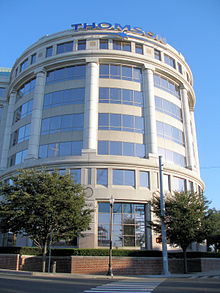The Thomson Corporation
| The Thomson Corporation
|
|
|---|---|
| legal form | Corporation |
| founding | 1989 |
| resolution | April 17, 2008 |
| Reason for dissolution | Merger to form Thomson Reuters |
| Seat |
Toronto , Canada (Headquarters in Stamford , Connecticut , United States )
|
| management | Richard J. Harrington, President & CEO, David Thomson |
| Number of employees | 32,000 (2007) |
| sales | 6,641,000,000 US dollars (2006) |
| Branch | Services |
The Thomson Corporation was a media company that started out as a Canadian newspaper publisher. The company was registered as a public company on the Commercial Register in Toronto , Ontario . The head office was located in Stamford , in the US state of Connecticut .
After the takeover of the world's largest news agency Reuters , the newly created group has been called Thomson Reuters since April 17, 2008 and has its headquarters in New York .
Company profile
The original newspaper publisher was transformed into a major provider of electronic information and services. Roy Herbert Thomson, 1st Baron Thomson of Fleet , founded the company. The company's name came about in 1989 after the merger of Thomson Newspapers and the International Thomson Organization .
The group was 70 percent owned by the Canadian Thomson family and was controlled by the family's The Woodbridge Company from Toronto.
The ordinary shares of Thomson Corporation were listed on the New York and Toronto exchanges (TSX: TOC, NYSE: TOC).
The Thomson Corporation most recently provided information services and software applications to over 20 million users in the law, tax, accounting , financial services, higher education, reference information, corporate training and assessment, scientific research and health care sectors.
The Thomson Corporation's five major global companies were:
- Thomson Legal
- Thomson Tax and Accounting
- Thomson Financial
- Thomson Scientific
- Thomson Healthcare
The Thomson Learning division was sold to Apax Partners in May 2007 and later renamed Cengage Learning .
history
The company was founded by Roy Herbert Thomson. He acquired the Canadian newspaper The Timmins Press in 1934 . By the end of the 1950s, the company had developed into a global media group. She owned several well-known newspapers in Great Britain including The Sunday Times and The Scotsman and also Scottish Television .
In the 1960s, Thomson's publishing group continued to expand to include Thomson Publication (UK), a general-interest magazine and book publisher and owner of The Times in London . In 1965 Thomson Newspapers, Ltd. a publicly traded company in Canada. Roy Thomson received the hereditary title of Baron Thomson of Fleet . Thomson's entrepreneurial interests now extended beyond publishing. Thomson Travel was founded in 1965. In the same year the airline Britannia Airways was taken over. In 1971, the company participated in a consortium that explored the North Sea in search of oil and gas.
In the late 1970s the circulation of newspapers owned by Thomson in the United States was over a million. The company took its name in 1989 on the occasion of the merger of Thomson Newspapers and the international Thomson Organization .
Over time, the company withdrew from the oil and gas business. The company's founder, who died in 1976, was succeeded by Kenneth Thomson, 2nd Baron Thomson of Fleet .
- Transition from newspapers to business and specialist information
In 1978 Thomson entered the specialized information market, college textbooks, and professional textbooks through the acquisition of Wadsworth Publishing .
From the mid-1990s onwards, Thomson continued to invest in specialized information services, now offered in digital format, and began selling its newspapers. Around that time, Richard J. Harrington, an accountant, became the company's chief executive officer. One of the first moves under this strategy was the acquisition of the legal publishing group West Publishing Company for $ 3.4 billion.
Thomson provided much of the specialized information legal, research, and medical organizations around the world need on a daily basis. Although the company remains a publishing group, early and aggressive investments in electronic forms of distribution are a central element of the company's strategy.
“With the exception of the educational division, which still produces large numbers of conventional textbooks, Thomson was fortunate to expand into these areas at a time when customers were demanding that information be delivered electronically ... succeeded in some markets it Thomson to outperform other market players who were more cautious about investing in digitization . "
Kenneth Thomson died in June 2006. Chairman was then his son David Thomson .
Well-known brands of Thomson are or were Thomson Dialog , Web of Science , Jane's Information Group , EndNote , Thomson Financial , Westlaw , InfoTrac and Thomson Gale .
The Thomson Group announced in May 2007 its intention to take over the Reuters news agency . The purchase price should be the equivalent of 12.9 billion euros.
Main competitors
Individual evidence
- ↑ about us
- ↑ Annual Report 2006
- ↑ Roland Lindner, "A family empire the Canadian way. The Thomsons are a cautious media dynasty - and have the largest fortune in the country," FAZ May 9, 2007, p. 19
- ↑ a b c d e In Canada, the Torch is Passed on a Quiet but Profitable Legacy by Ian Austen, The New York Times (Business Day section) p. C1, July 3, 2006; Retrieved July 3, 2006
- ↑ Financial Times Europe (July 27, 2007) p. 13

